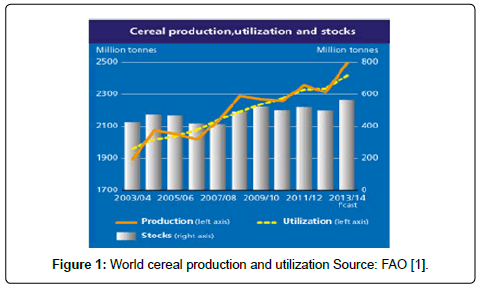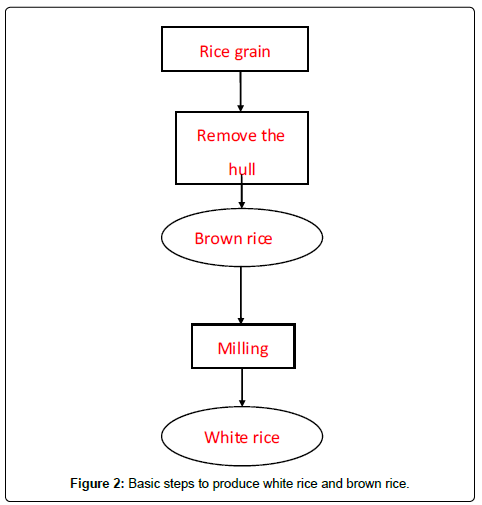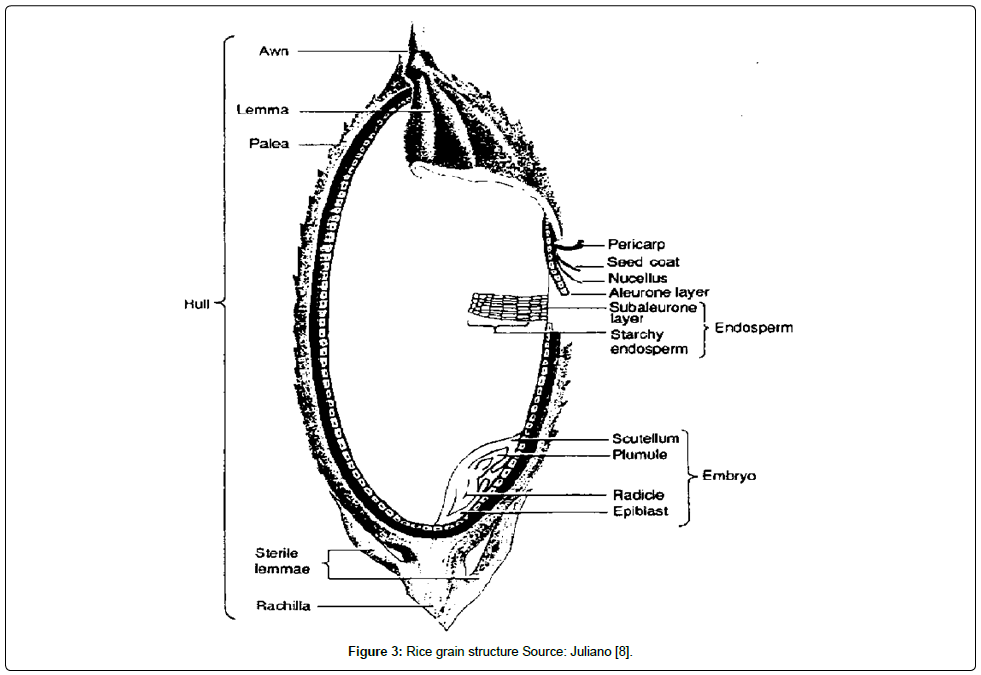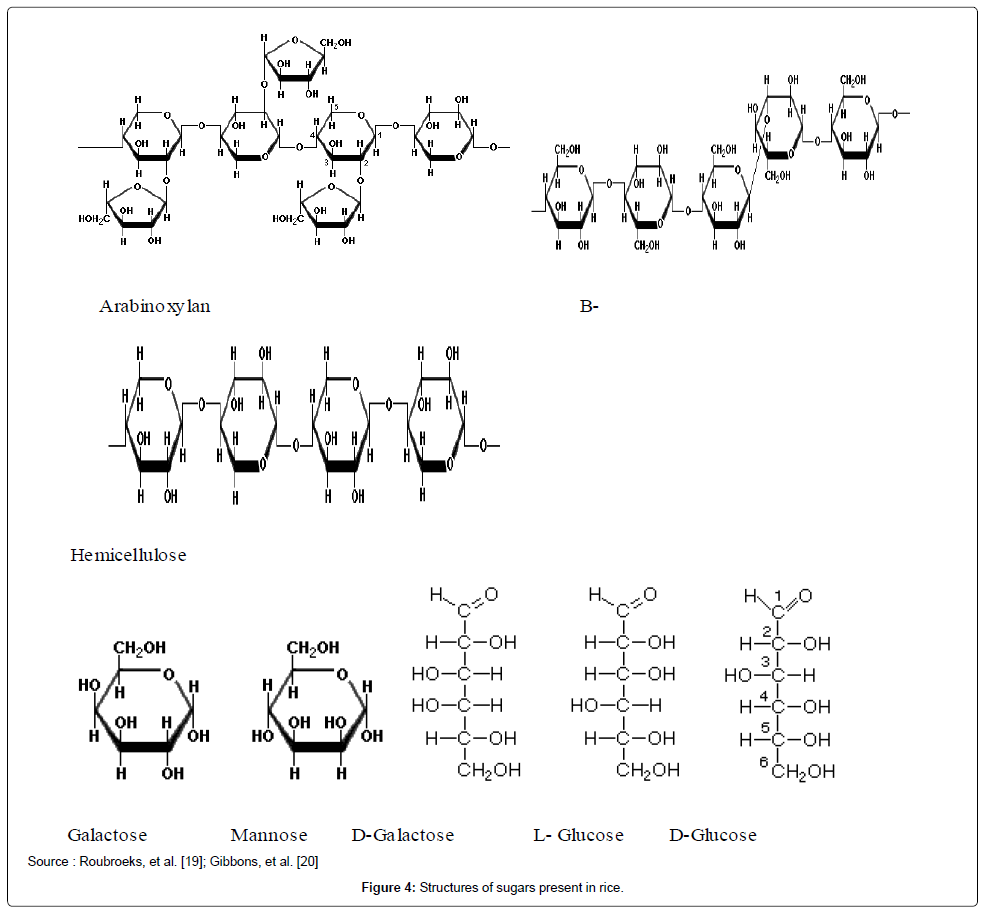Editorial Open Access
Rice as a Source of Fibre
Binosha Fernando*
School of Medical Sciences, Edith Cowan University, Western Australia
- *Corresponding Author:
- Binosha Fernando
School of Medical Sciences
Edith Cowan University, Western Australia
Tel: 0863045844
Fax: 61 08 6304 5851
E-mail: w.fernando@ecu.edu.au
Received date: November 19, 2013; Accepted date: November 20, 2013; Published date: November 21, 2013
Citation: Fernando B (2013) Rice as a Source of Fibre. J Rice Res 1:e101.
Copyright: © 2013 Fernando B. This is an open-access article distributed under the terms of the Creative Commons Attribution License, which permits unrestricted use, distribution, and reproduction in any medium, provided the original author and source are credited.
Visit for more related articles at Rice Research: Open Access
Dietary fibre comes from plant food. Cereals are good source of dietary fibre (Table 1 and 2).
| Rice fraction | Crude protein (g N x 5. 95) |
Crude fat (g) | Crude fibre (g) | Crude ash (g) | Available carbohydrates (g) | Neutral detergent fibre (g) | Energy content (kJ) |
|---|---|---|---|---|---|---|---|
| Rough rice | 5.8-7.7 | 1.5-2.3 | 7.2-10.4 | 2.9-5.2 | 64-73 | 16.4-19.2 | 1580 |
| Brown rice | 7.1-8.3 | 1.6-2.8 | 0.6-1.0 | 1.0-1.5 | 73-87 | 2.9-3.9 | 1520-1 610 |
| Milled rice | 6.3-7.1 | 0.3-0.5 | 0.2-0.5 | 0.3-0.8 | 77-89 | 0.7-2.3 | 1460-1 560 |
| Rice bran | 11.3-14.9 | 15.0-19.7 | 7.0-11.4 | 6.6-9.9 | 34-62 | 24-29 | 670-1 990 |
| Rice hull | 2.0-2.8 | 0.3-0.8 | 34.5-45.9 | 13.2-21.0 | 22-34 | 66-74 | 1110-1 390 |
Table 1: Approximate composition of rough rice.
| Rice Type Type of Nutrition |
Brown | White -polished | Red | purple | Black | white |
|---|---|---|---|---|---|---|
| Protein(g/100g) | 7.9 (*) | 6.8(*) | 7.0 (*) | 8.3 (*) | 8.5 (*) | - |
| Iron(mg/100g) | 2.2 (*) | 1.2(*) | 5.5 (*) | 3.9 (*) | 3.5 (*)) | - |
| Zinc(mg/100g) | 05 (*) | 05 (*) | 3.3 (*) | 2.2 (*) | - (*) | - |
| Fibre(g/100g) | 2.8( *) | 0.6(*) | 2.0(*) | 1.4 (*) | 4.9(*) | |
| Crude Protein (Dry weight%) | 7.3 (**) | - | - | - | - | - |
| Crude Fat (Dry weight%) | 2.2 (**) | - | - | - | - | - |
| Ash (Dry weight%) | 1.4 ( **) | - | - | - | - | - |
| Crude Fibre (Dry weight%) | 0.8 (**) | - | - | - | - | - |
| Available carbohydrate (Dry weight%) | 64.3 (**) | - | - | - | - | - |
| Crude fibre% (Dry weight) | 1.0%(***) | - | - | - | - | 0.3% (***) |
| Carbohydrate% (Dry weight) | 88%(***) | - | - | - | - | 91%(***) |
| Protein% (Dry Weight) | 8.5%(***) | - | - | - | - | 7.6%(***) |
| Lipid(crude fat)% (Dry weight) | 2.2%(***) | - | - | - | - | 0.5%(***) |
Table 2: Proximate analyses of different rice types.
The production, utilization, and stocks of cereal in the world increases each year (Figure 1) among the cereals rice is the second largest produced cereal in the world [1]. Rice is edible starchy cereal grain. Large part of the world population, including virtually all of East and Southeast Asia, is wholly dependent upon rice as a staple food; 95 percent of the world’s rice production is eaten by humans and has been a source of food for people from 2500 B.C. Rice production was initiated in China, and spread to countries such as Sri Lanka and India [2]. Twenty percent of the world’s dietary energy is provided by rice which is higher than either wheat or maize [3]. In addition rice is an important grain for nutrition and caloric intake [4].
Rice (Table 3) is an excellent food source and rich in vitamins and fibre. Freshly harvested rice is called paddy grain or rough rice. The rice grain (rough rice) consists of the hull, and the rice caryopsis [5]. Underneath the hull, bran, germ, and endosperm are present. Rice is classified basically in to two forms; brown and white rice. Brown rice is produced by dehusking the hull (Figure 2). Un-milled rice has more protein and fibre than the milled or polished rice and can be considered as more nutritious [6]. Rice is ground into several milling grades to obtain the different types of rice flours and grains. This includes: brown rice (only hull removed), unpolished rice (hull, bran and most of the germ removed), and polished rice (aleurone layer removed from unpolished rice) [7]. As in (Table 1 and 2), the major impact of milling on rice is to manipulate the nutritional composition of the grain.
| Food | Moisture (%) | Protein (g Nx 6.25) | Crude fat (g) | Available carbohydrates (g) | Fibre (g) | Crude ash (g) | Energy (kJ) | ||
|---|---|---|---|---|---|---|---|---|---|
| Dietary Total |
Water insoluble | Lignin | |||||||
| Brown rice | 14 | 7.3 | 2.2 | 71.1 | 4 | -2.7 | -0.1 | 1.4 | 1 610 |
| Wheat | 14 | 10.6 | 1.9 | 61.6 | 10.5 | -7.8 | -0.6 | 1.4 | 1 570 |
| Maize | 14 | 9.8 | 4.9 | 60.9 | 9 | -6.8 | 0 | 1.4 | 1 660 |
| Millet | 14 | 11.5 | 4.7 | 64.6 | 37 | -2.3 | 0 | 1.5 | 1 650 |
| Sorghum | 14 | 8.3 | 3.9 | 57.4 | 13.8 | -12.4 | -3 | 2.6 | 1 610 |
| Rye | 14 | 8.7 | 1.5 | 60.9 | 13.1 | -8.4 | (1 4) | 1.8 | 1 570 |
| Oats | 14 | 9.3 | 5.9 | 63 | 5.5 | -39 | 0 | 2.3 | 1 640 |
| Potato | 77.8 | 2 | 0.1 | 15.4 | 2.5 | -1.9 | 0 | 1 | 294 |
| Cassava | 63.1 | 1 | 0.2 | 31.9 | 2.9 | -2.2 | 0 | 0.7 | 559 |
| Yam | 71.2 | 2 | 0.1 | 22.4 | 3.3 | -2.6 | 0 | 1 | 411 |
Table 3: Comparison of cereals on nutrients basis.
Brown rice consists of the outer layers (pericarp, seed-coat), and the nucleus (bran), the germ or embryo; and the endosperm (Figure 3). The endosperm consists of the aleuronic layer and the endosperm proper (subaleurone layer and the starchy or inner endosperm). The aleuronic layer encloses the embryo. Pigment is confined to the pericarp [8] which gives the colour to brown rice.
Different layers (Figure 2) of rice have different quantities of fat, carbohydrate, protein and fibre, and removing the different layers in the milling process alters nutritional quality. The milling of brown rice involves the removal of the pericarp (outer bran layer), seed-coat, aleuronic layer, and embryo. This results in the loss of fat, protein, crude and neutral detergent fibre, ash, thiamine, riboflavin, niacin and a-tocopherol in milled rice (Table 1). The other fraction of the rice grain, rice bran, contains an appreciable quantity of crude fibre. Rice bran fibre largely consists of non cellulosic polysaccharide (24%), cellulose 10.3%), and lignin (10.7%) [9].
The nutritional composition of rice differs with variety, condition of the soil, environmental factors, and fertilizers used [10,11].
Soluble and Insoluble Fibre in Rice
Arabinoxylans, along with some amount of β-d-glucans (Figure 2), are the major components of SDF (soluble dietary fibre) [12] present in rice. In addition, rhamnose, xylose, mannose, galactose, and glucose (Figure 4), can be found as part of the SDF [12]. Cellulose hemi cellulose and insoluble β-glucan and arabinoxylans make up the IDF (insoluble dietary fibre) [13]. However, the amount and the quantity of these non starch polysaccharides in rice are dependent upon the rice cultivar, degree of milling, and water solubility. In addition the water solubility of non starch polysaccharides is mainly governed by the rice variety, rather than the degree of milling [13].
References
- FAO, Food and Agriculture organisation news letter (2013)
- Te-Tze C. (2000) II.A.7. Rice. In: The Cambridge World History of Food. Cambridge University Press.
- Anon (2004) International year of rice. Rice and Human Nutrition
- Souci SW, Fachmann W, Kraut H (1986) Food Composition and Nutrition Tables 1986/87, Wissenschaftliche Verlagsgesellschaft, Stuttgart.
- Juliano BO, Bechtel DB (1985) The rice grain and its gross composition. In: Rice chemistry and technology, USA.
- International rice commission (2004) Rice is life. International year of rice 2004 and its implementations. International rice commission, Food and Agricultural Organisation of the United Nations.
- Haard NF, Odunfa SA, Lee C, Quintero-Ramirez R, Lorence-Quinones A, et al. (1999) Fermented Cereals: A global perspective. FAO Agricultural Services Bulletin.
- Juliano BO (1993) Grain structure, composition and consumers. In: Rice in human Nutrition. International rice research institute and food and agriculture organization of the United Nations, Rome
- Sera N, Morita K, Nagasoe M, Tokieda H, Kitaura T, et al. (2005) Binding effect of polychlorinated compounds and environmental carcinogens on rice bran fibre. The Journal of Nutritional Biochemistry 16: 50-58.
- Juliano BO, Albano EL, Cagampang GB (1964) Variability in protein content and alkali digestibility of rice varieties in Asia. Philippine Agriculturist 48:234-456.
- Amissah JGN, Ellis WO, Oduro I, Manful JT (2003) Nutrient composition of bran from new rice varieties under study in Ghana. Food Control, 14: 21-24.
- Rao RSP, Muralikrishna G (2004) Non-starch polysaccharide–phenolic acid complexes from native and germinated cereals and millet, Food Chemistry, 84: 527–531.
- Lai VMF, Lu S, He WH, Chen HH (2007) Non-starch polysaccharide compositions of rice grains with respect to rice variety and degree of milling. Food Chemistry, 101: 1205-1210.
- Eggum BO, Juliano BO, Maniñgat CC (1982) Protein and energy utilization of rice milling fractions by rats. Plant Foods for Human Nutrition, 31: 371 -376
- Pedersen B, Eggum BO (1983) The influence of milling on the nutritive value of flour from cereal grains. Plant Foods for Human Nutrition, Plant Foods for Human Nutrition 33: 267-278.
- Food and Agriculture organisation (2004) Rice and human nutrition. International year of rice 2004. FAO, Italy.
- Alais C, Linden G (1991) Food Biochemistry. Ellis Horwood Ltd.
- Dendy DAV (2001) Composition and nutritional value of rice and byproducts, In: cereal and cereal products.
- Roubroeks JP, Andersson R, Mastromauro DI, Christensen BE, Aman P (2001) Molecular weight, structure and shape of oat (1?3),(1?4)-b-D-glucan fractions obtained by enzymatic degradation with (1?4)-b-D-glucan 4-glucanohydrolase from Trichoderma reesei, Carbohydrate Polymers, 46: 275-285.
- Gibbons BJ, Roach PJ, Hurley TD (2002) Crystal Structure of the autocatalytic initiator of glycogen synthesis, glycogenin. Journal of Molecular Biology, 319:463-477.
Relevant Topics
- Basmati Rice
- Drought Tolerence
- Golden Rice
- Leaf Diseases
- Long Grain Rice
- Par Boiled Rice
- Raw Rice
- Rice
- Rice and Aquaculture
- Rice and Nutrition
- Rice Blast
- Rice Bran
- Rice Diseases
- Rice Economics
- Rice Genome
- Rice husk
- Rice production
- Rice research
- Rice Yield
- Sticky Rice
- Stress Resistant Rice
- Unpolished Rice
- White Rice
Recommended Journals
Article Tools
Article Usage
- Total views: 27534
- [From(publication date):
December-2013 - Apr 05, 2025] - Breakdown by view type
- HTML page views : 22569
- PDF downloads : 4965




